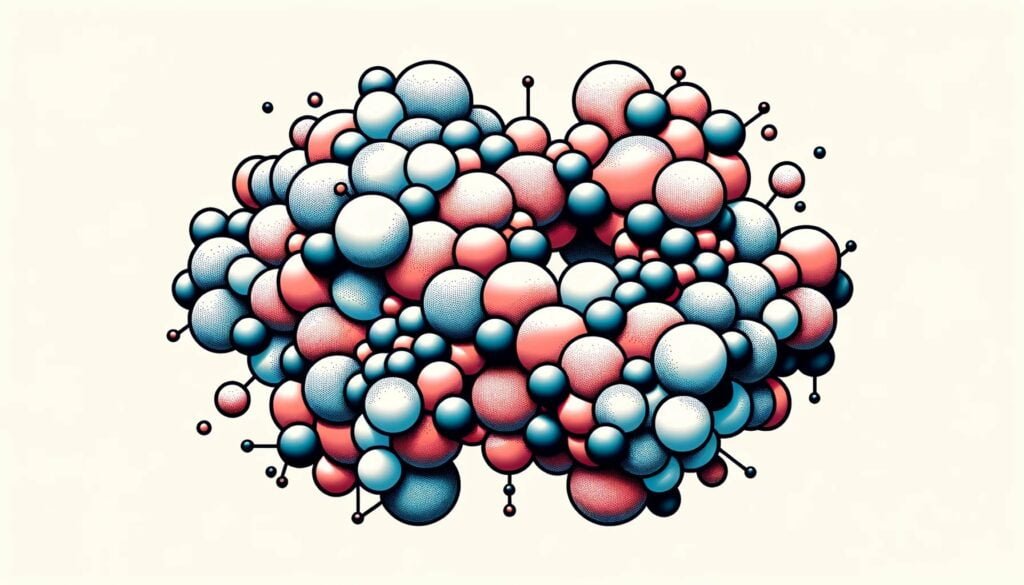When it comes to understanding the fascinating world of precipitation reactions, the intricate mechanisms at play can often leave many intrigued. Have you ever wondered what exactly happens during these reactions? How do the mysterious particles materialize before our eyes? In this article, we will delve into the captivating realm of precipitation reactions and explore the enigmatic chemistry behind this mesmerizing phenomenon. Prepare to uncover the secrets of this captivating chemical process as we decipher the intricate dance of particles in a precipitation reaction.
What happens in precipitation reaction?
A precipitation reaction is like a dance of charged particles in an aqueous solution, resulting in the formation of an insoluble salt. It’s a captivating display of chemistry at work where two ionic bonds join together, giving birth to a new substance known as a precipitate. Imagine a graceful waltz between two partners, where their steps interlock, leading to a mesmerizing formation that captures the essence of this reaction.
In this captivating performance, the reactant ions mingle and interact, guided by the laws of attraction and repulsion. The solution acts as a stage, providing the perfect environment for their chemistry to unfold. As the dancers, or ions, gracefully float in the liquid, they collide and embrace, forming delicate bonds.
Once the partnering ions find each other, they undergo a transformation, coupling their charges together. This elegant chemistry creates an insoluble compound, a precipitate, that materializes before our eyes. This precipitate takes various forms, ranging from a fine powder to a solid mass or even a crystal.
The precipitate, being insoluble, can no longer remain part of the solution. It either gracefully sinks to the bottom, creating a beautiful sediment, or it lingers in a suspended state, swirling and twirling through the liquid. It’s as if the precipitate wants to continue dancing, showcasing its newfound existence.
Let’s take a real-life example to illustrate this captivating chemistry. Imagine a colorless solution of silver nitrate joining hands with a yellow-orange solution of potassium dichromate. Their encounter sparks a breathtaking reaction, leading to the formation of a reddish precipitate of silver dichromate. This is just one of the many enchanting acts that precipitation reactions have to offer.
Now, to further enrich your understanding, let’s dive into the mechanics behind this enthralling performance. The process of precipitation reactions is driven by the principle of solubility. Ions in an aqueous solution have different solubilities. Some compounds dissolve readily, while others have a strong inclination towards forming insoluble salts.
When two soluble compounds are mixed together, changes occur at the molecular level. The ions in the solution rearrange themselves, seeking new partners that can create stable compounds. If the resulting compound has low solubility, it will precipitate out of the solution.
It’s like a grand puzzle where each ion fits perfectly into its designated slot, forming a stable and solid compound. This process is governed by the solubility rules, which guide us in predicting which combinations of ions will likely form precipitates.
In the world of precipitation reactions, the choreography is not limited to just two partners. Multiple ions can join the dance, spawning intricate patterns of precipitates. These patterns depend on factors such as the concentration of the ions, temperature, and pH of the solution. By manipulating these conditions, chemists can control the outcome of the reaction, creating specific precipitates with desired properties.
But why is understanding precipitation reactions so crucial in the realm of chemistry? These reactions have wide-ranging applications, from the purification of water to the synthesis of new materials. They play a vital role in industries such as pharmaceuticals, environmental science, and even art restoration.
In conclusion, the enchanting world of precipitation reactions holds many secrets waiting to be unraveled. By understanding the intricacies of this dance between ions, chemists can wield this knowledge to their advantage. It’s a captivating chemistry performance where dancing ions create new substances, forming a visual spectacle of precipitates. So the next time you witness a precipitate forming, take a moment to ponder the intricate steps that brought it to life, and appreciate the beauty that lies within this mesmerizing chemistry.
The water cycle is a fascinating natural process that keeps our planet alive and thriving. One essential element of this cycle is precipitation. Have you ever wondered how rain, snow, or hail is formed? Learn more about the captivating concept of precipitation in the water cycle by clicking here. Explore the intricate details behind this mesmerizing phenomenon and deepen your understanding of how nature works its magic. The precipitation water cycle link will take you on an educational journey that will leave you in awe of the wonders of our planet.
Factors Influencing Precipitation Reactions
Have you ever wondered what happens when certain aqueous solutions are mixed together? Well, you’re about to uncover the hidden chemistry behind precipitation reactions. In this article, we will delve into the fascinating world of precipitation reactions and explore the factors that influence their outcomes. So, let’s get started!
What Are Precipitation Reactions?
Precipitation reactions occur when two aqueous solutions containing different ions are mixed, leading to the formation of an insoluble ionic solid called a precipitate. These reactions involve the exchange of ions between the solutions, resulting in the rearrangement of ions to form new compounds. In simpler terms, it’s like a molecular dance party where the ions mingle and interact, forming delicate bonds that transform the solution.
The Role of Solubility
Solubility plays a crucial role in precipitation reactions. It determines whether a compound will dissolve in a given solvent or form a precipitate. By understanding the solubility rules, we can predict which combinations of ions are likely to form insoluble salts. These rules guide us in determining the products of a precipitation reaction.
Factors Influencing Precipitation Reactions
Now, let’s dive into the factors that can influence precipitation reactions. These factors include:
- Temperature: The temperature of the solution can significantly impact the formation of precipitates. In general, an increase in temperature enhances the solubility of most compounds, making them more likely to remain dissolved rather than form a precipitate. However, there are exceptions to this rule, such as the solubility of certain salts that decrease with increasing temperature.
- Concentration: The concentration of the solutions involved in a precipitation reaction also plays a vital role. Higher concentrations of ions in the solution increase the likelihood of collisions between ions, leading to more frequent precipitation events. Similarly, a higher concentration of reactants increases the chances of a precipitation reaction occurring.
- pH: The pH of the solution can affect the solubility of specific compounds, thereby influencing precipitation reactions. Certain ions exhibit pH-dependent solubility, meaning their solubility changes with variations in acidity or alkalinity. Understanding the pH-dependent behavior of these ions helps us predict and manipulate precipitation reactions.
- Presence of Common Ions: The presence of common ions can affect the solubility of compounds and consequently influence precipitation reactions. Common ions are ions that are present in the solution and come from both the reactants and the products of the reaction. When a solution already contains a high concentration of one of the ions involved in the formation of a precipitate, it reduces the solubility of that compound and promotes the precipitation reaction.
- Ionic Strength: The ionic strength, which depends on the total concentration of ions in the solution, affects the solubility of compounds. Higher ionic strength can increase the tendency of a compound to precipitate.
The Impact of Factors on Precipitation Reactions
By considering these factors in precipitation reactions, we can make predictions and gain a better understanding of what will occur when specific solutions are mixed. This knowledge is vital in various fields, including chemical analysis, environmental science, pharmaceuticals, and more. For example, in the field of pharmaceuticals, understanding the factors influencing precipitation reactions is essential to ensure the effectiveness and stability of medications.
Conclusion
Precipitation reactions are truly intriguing chemical phenomena that involve the formation of insoluble compounds in solution. By taking into account various factors such as temperature, concentration, pH, presence of common ions, and ionic strength, we can unravel the intricacies of precipitation reactions and make predictions about their outcomes. This knowledge opens up avenues for further research and application in a wide range of industries. So, the next time you witness a precipitate forming, remember that it’s the result of a delicate dance between the ions influenced by a myriad of factors.
Applications and Significance of Precipitation Reactions
Precipitation reactions, a fascinating branch in the realm of chemistry, hold immense applications and significance in various fields. From water purification to material synthesis, pharmaceuticals to environmental science, and even art restoration, the understanding of precipitation reactions plays a pivotal role. Through this article, we will unveil the chemistry behind precipitation reactions and explore their diverse applications. So, let’s dive in!
1. Precipitation Reactions: What Happens?
When two solutions containing soluble salts are mixed, an intriguing chemical phenomenon occurs – precipitation reactions. These reactions result in the formation of a solid substance known as a precipitate. Typically, the precipitate is an insoluble ionic compound. For instance, when silver nitrate and sodium chloride solutions are combined, silver chloride precipitates, while sodium nitrate remains in solution.
2. Testing Ions and Analyzing Solutions
One of the key applications of precipitation reactions lies in their ability to test for the presence of different ions in a solution. Through carefully chosen reactants, we can detect the presence of specific ions by observing the formation of precipitates. For example, by mixing silver nitrate with potassium chloride, we can identify the presence of chloride ions through the formation of silver chloride precipitate.
3. Factors Influencing Precipitation Patterns
The formation of precipitates is influenced by various factors, including concentration, temperature, and pH of the solution. Concentration plays a significant role, as higher concentrations of ions and reactants increase the likelihood of precipitation events. Temperature also affects precipitation reactions, although exceptions exist. In general, increasing temperature enhances solubility, but certain compounds exhibit different behavior. pH, another important factor, can influence solubility and subsequently impact precipitation reactions. Additionally, the presence of common ions and the ionic strength, dependent on the total concentration of ions, can influence the tendency of a compound to precipitate.
4. Wide Range of Applications
Precipitation reactions find applications in a multitude of fields, emphasizing their significance. Let’s explore some key applications in more detail:
- Water Purification: Precipitation reactions are extensively employed in water treatment processes to remove impurities. By inducing precipitation, undesirable compounds and heavy metals can be removed from water sources, ensuring clean and safe drinking water for the population.
- Material Synthesis: Precipitation reactions play a crucial role in the synthesis of various materials. They are utilized to create nanoparticles, catalysts, and functional materials with distinct properties. By controlling the precipitation process, researchers can engineer materials with desired characteristics, paving the way for technological advancements.
- Pharmaceutical Industry: Precipitation reactions find immense utility in pharmaceutical formulation and drug development. They aid in the purification and isolation of compounds, the synthesis of active pharmaceutical ingredients, and the controlled release of drugs. Understanding precipitation reactions is of paramount importance in ensuring the effectiveness and safety of pharmaceutical products.
- Environmental Science: Precipitation reactions are closely involved in environmental studies, particularly in the analysis of water and soil contaminants. Through precipitation tests, scientists can identify and quantify the presence of pollutants, aiding in environmental monitoring and remediation efforts.
- Art Restoration and Conservation: In the world of art restoration, precipitation reactions are employed to conserve and restore artifacts. By understanding the chemical reactions that occur within the materials used in artworks, conservators can develop appropriate treatment methods to preserve these valuable cultural assets.
In Conclusion
Precipitation reactions, with their mesmerizing chemistry, find applications and hold great significance in various fields. From testing ions to water purification, material synthesis to pharmaceutical development, and environmental analysis to art restoration, these reactions play a vital role in advancing our understanding and improving numerous aspects of our lives. By unraveling the intricacies of precipitation reactions, scientists and researchers continue to unlock new possibilities and push the boundaries of scientific knowledge.
So, the next time you witness the formation of a beautiful precipitate, remember the immense applications and significance that lie hidden within this captivating chemical phenomenon.
Table: Common Precipitates in Precipitation Reactions
| Precipitate | Compound |
|---|---|
| Silver Chloride | AgCl |
| Calcium Hydroxide | Ca(OH)2 |
| Lead Sulfide | PbS |
| Barium Sulfate | BaSO4 |
| Iron(III) Hydroxide | Fe(OH)3 |
| Aluminum Phosphate | AlPO4 |
| Copper(II) Hydroxide | Cu(OH)2 |
| Mercury(II) Iodide | HgI2 |
| Zinc Carbonate | ZnCO3 |
| Strontium Sulfate | SrSO4 |
Remember, in precipitation reactions, these insoluble compounds emerge, giving rise to the mesmerizing beauty of chemistry!
FAQ
Question 1
What is a precipitation reaction?
Answer 1
A precipitation reaction is a chemical reaction that occurs in an aqueous solution where two ionic bonds combine, resulting in the formation of an insoluble salt called a precipitate. The precipitate can take the form of a powder, solid mass, or crystal that either sinks to the bottom of the liquid solution or stays in suspension.
Question 2
What factors can affect precipitation reactions?
Answer 2
Several factors can influence precipitation reactions, including temperature and concentration of the solution. Higher temperatures can increase the rate of the reaction, while higher concentrations of reactants can promote more extensive precipitation. Additionally, the presence of other substances in the solution, such as impurities, can affect the formation of a precipitate.
Question 3
How can the products of a precipitation reaction be predicted?
Answer 3
The products of a precipitation reaction can often be predicted using solubility rules for common ionic solids. These rules outline the solubility of different compounds in water, allowing chemists to determine which combinations of ions will form an insoluble precipitate. By understanding the solubility properties of various substances, one can anticipate the outcome of a precipitation reaction.
Question 4
What is the significance of net ionic equations in precipitation reactions?
Answer 4
Net ionic equations are commonly used to represent precipitation reactions. These equations only include the essential components of the reaction, excluding spectator ions that do not participate in forming the precipitate. By focusing on the ions directly involved in the reaction, net ionic equations provide a clearer and simpler representation of the chemical process taking place.
Question 5
Why are precipitation reactions important in various fields?
Answer 5
Precipitation reactions have significant implications in different fields, including chemical analysis and environmental science. In chemical analysis, these reactions are utilized to detect and identify the presence of specific ions in a solution. In environmental science, precipitation reactions can help in understanding phenomena such as acid rain, where rainwater reacts with pollutants in the atmosphere. Additionally, precipitation reactions are crucial in industries like pharmaceuticals, where the formation of insoluble compounds can impact the effectiveness of medications.
- Amazing March Fun Facts: Unveiling History & Celebrations - April 15, 2025
- Master how to write height: A complete guide - April 15, 2025
- How High Are Your Standards Test: Find Your Perfect Match Now - April 15, 2025



















